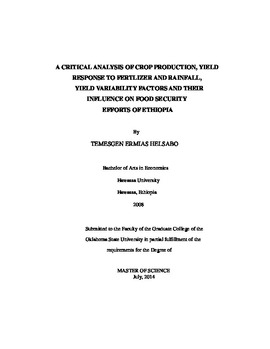| dc.contributor.advisor | Stoecker, Arthur | |
| dc.contributor.author | Helsabo, Temegen Ermias | |
| dc.date.accessioned | 2015-06-17T20:06:17Z | |
| dc.date.available | 2015-06-17T20:06:17Z | |
| dc.date.issued | 2014-07-01 | |
| dc.identifier.uri | https://hdl.handle.net/11244/14880 | |
| dc.description.abstract | For the past three decades, African agricultural crop production has been increasing. However, much of exhibited growth has come from additional harvested land rather than the increased yield per hectare. This paper studies crop production of the world, African in general, East Africa, and then gives particular focus on Ethiopia. In addition to crop production comparison, the economics of fertilizer, the yield trends and best operating condition under yield and price risk are examined. Moreover, it aims to determine the crop yield response to fertilizer and optimum level of fertilizer under risk. The data were obtained from the Ethiopian statistical agency yearly survey. The fourteen-year daily rainfall data were obtained from Global weather for SWAT database. Time series cross section regression were used to determine the crop yield response to fertilizer. Based on Dillon's analysis the best operating conditions under risk were determined. The variance of product price risk was used to determine the marginal cost of risk. The value cost ratio (VCR) method, which has been used in several studies to recommend profitable quantity of fertilizer was rejected in this study. The limitations of VCR are discussed based on economic theories. Results indicated there were significant differences between crop yield responses to fertilizer. Oromia and SNNPR regions give greater yield response to fertilizer for teff and wheat than other regions respectively. However, the crop price risk of wheat and teff was estimated to cause 316,000 quintals less use of fertilizer to be used in the four major crop growing regions than would have been used in the absence of price risk. Consequently, the four regions lost about 178,488 quintals of teff and 401,624 quintals of wheat that would have been gained from 1,502,249 and 1,122,969 hectares of fertilized portion of land in the year 2012. If product prices had been stable and 15% more land was fertilized, about 5.9%, 5.6 %, 4.4 % and 4.8 % more production from teff and 5.1%, 5.3%, 3.2% and 2.6% more wheat production would have been gained in Tigray, Amhara, Oromia and SNNPR regions respectively. This indicates that in the prevailing condition, maintaining only crop price stability would help more land to be fertilized and to increase the supply of food for the country while endeavoring to attain sustainable food security. | |
| dc.format | application/pdf | |
| dc.language | en_US | |
| dc.publisher | Oklahoma State University | |
| dc.rights | Copyright is held by the author who has granted the Oklahoma State University Library the non-exclusive right to share this material in its institutional repository. Contact Digital Library Services at lib-dls@okstate.edu or 405-744-9161 for the permission policy on the use, reproduction or distribution of this material. | |
| dc.title | Critical Analysis of Crop Production, Yield Response to Fertlizer and Rainfall, Yield Variability Factors and Their Influence on Food Security Efforts of Ethiopia | |
| dc.type | text | |
| dc.contributor.committeeMember | Chung, Chanjin | |
| dc.contributor.committeeMember | Miller, Edwin | |
| osu.filename | HELSABO_okstate_0664M_13412.pdf | |
| osu.accesstype | Open Access | |
| dc.description.department | Agricultural Economics | |
| dc.type.genre | Thesis | |
| dc.subject.keywords | best operation envirnoment under risk | |
| dc.subject.keywords | crop productivity in african and ethiopia | |
| dc.subject.keywords | crop yiled response to fertilizer | |
| dc.subject.keywords | food security | |
| dc.subject.keywords | price risk effect on crop productivity | |
| dc.subject.keywords | profitability of fertilizer | |
